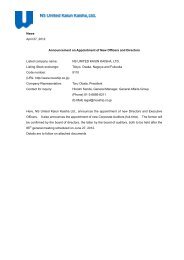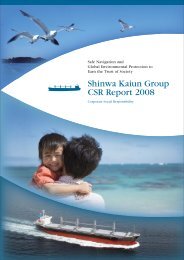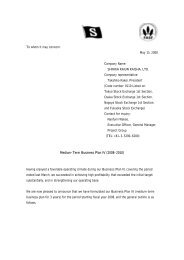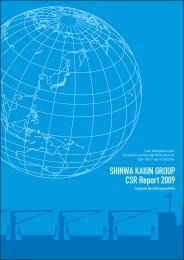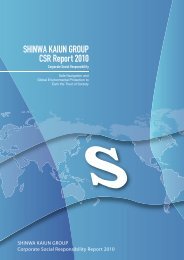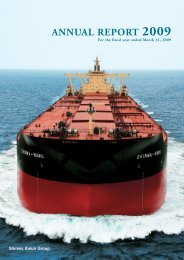You also want an ePaper? Increase the reach of your titles
YUMPU automatically turns print PDFs into web optimized ePapers that Google loves.
Sectoral Overview<br />
Eighty-plus percent of the consolidated revenue of the<br />
Shinwa Kaiun Group is from overseas shipping<br />
services, while the coastal shipping services, driven by<br />
our consolidated subsidiaries Shinwa Naiko Kaiun<br />
Kaisha, Ltd. and Shinwa Chemical Tanker Co., Ltd.,<br />
accounts for a little under 20%. The overseas shipping<br />
services comprise Shinwa Kaiun and SHINWA<br />
(SINGAPORE) PTE. LTD., which serve as shipping<br />
operators, Shinwa Marine Corp., which assumes<br />
shipping administration, and overseas owner subsidiaries.<br />
As for businesses other than shipping services, the<br />
Company operates Shinwa Business Management<br />
Kaisha, Ltd., which is engaged in property management<br />
services and entrusted with the administrative and<br />
accounting business of Group members, Shinwa<br />
Systems Co., Ltd., which is engaged in information<br />
systems development and maintenance, and Shinwa<br />
Engineering Services Co., Ltd., which is engaged in<br />
onshore equipment maintenance services.<br />
Operational reviews for overseas shipping<br />
services, coastal shipping services, and other services<br />
for the consolidated fiscal year under review are as<br />
follows.<br />
Overseas Shipping Services<br />
The charter market for Capesize bulk carriers<br />
(170,000-DWT class) was affected by sluggish cargo<br />
movements at the beginning of the fiscal year, due to<br />
production adjustment by steelmakers stemming<br />
from the rapid economic recession following the<br />
Lehman shock. However, average charter rates for<br />
main four routes reached a level surpassing 40,000<br />
U.S. dollars per day because of the recovery of iron<br />
ore imports by China in the second half of the fiscal<br />
year, as well as the recovery of crude steel production<br />
in Japan and Europe, resulting in a gradual increase<br />
in cargo movement and the tightening of supply and<br />
demand for vessels.<br />
In the Panamax bulk carrier (70,000-DWT class)<br />
market, charter rates for the Pacific round service<br />
remained sluggish, at around 10,000 U.S. dollars per<br />
day at the beginning of the fiscal year, because of a<br />
decline in transportation demand for Japan.<br />
However, rates rose to approximately 30,000 U.S.<br />
dollars per day toward the end of the fiscal year<br />
because cargo movements of coal and grain bound<br />
mainly for China and India were increasingly brisk<br />
after summer, and because supply and demand for<br />
vessels tightened, due partly to prolonged ship<br />
congestion in Australia.<br />
In the Handy bulk carrier (30,000-DWT class)<br />
market, charter rates for the Pacific round service<br />
remained sluggish, at approximately 8,000 U.S.<br />
dollars per day in the first half of the fiscal year.<br />
However, cargo movements increased as the world<br />
economy gradually recovered, and the market continued<br />
to show moderate growth. Furthermore, as demand<br />
for vessels notably increased after winter, charter rates<br />
reached a level surpassing approximately 20,000 U.S.<br />
dollars per day at the end of the fiscal year.<br />
While the transport of our main outward cargo,<br />
steel products from Japan to North America, slowed<br />
down, we worked to improve ship-deployment<br />
efficiency through booking combination cargo to<br />
Central and South America, and achieved success.<br />
We maintained stable profits through long-term<br />
contracts for nonferrous ore from the west coast of<br />
South America, one of our main homeward cargos.<br />
In grain transport from the Gulf Coast of the U.S. to<br />
the west coast of South America, we worked to<br />
improve profits through efficient deployment of our<br />
fleet, while benefitting from a market rise.<br />
In near-sea trade using small-sized carriers<br />
(5,000- to 10,000-DWT class), the transport of steel<br />
products bound for China and Southeast Asia<br />
remained at a much higher level than expected, while<br />
demand for the transport of raw materials bound for<br />
Japan was extremely sluggish.<br />
In the field of VLCCs (300,000-DWT-class<br />
tankers), VLGCs (80,000-cubic-meter liquefied gas<br />
7<br />
Shinwa Kaiun Group <strong>Annual</strong> <strong>Report</strong> <strong>2010</strong>


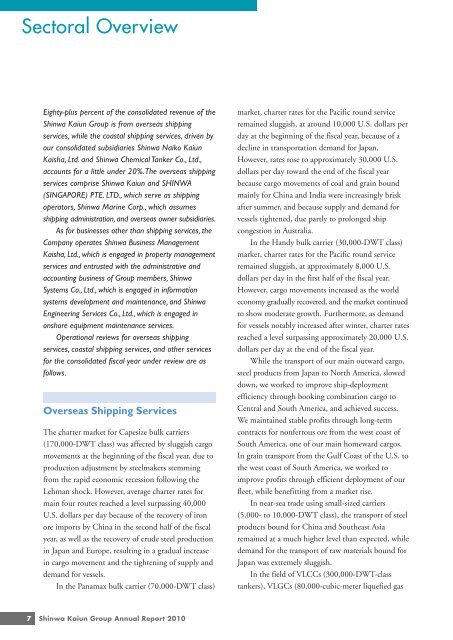
![[Consolidated] Balance Sheet (B/S)(PDF/35KB)](https://img.yumpu.com/49745625/1/184x260/consolidated-balance-sheet-b-spdf-35kb.jpg?quality=85)
